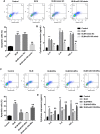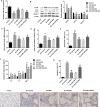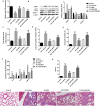Microvesicles derived from human Wharton's jelly mesenchymal stem cells enhance autophagy and ameliorate acute lung injury via delivery of miR-100
- PMID: 32169098
- PMCID: PMC7071666
- DOI: 10.1186/s13287-020-01617-7
Microvesicles derived from human Wharton's jelly mesenchymal stem cells enhance autophagy and ameliorate acute lung injury via delivery of miR-100
Abstract
Objectives: Microvesicles (MVs) derived from human Wharton's jelly mesenchymal stem cells (MSC-MVs) were demonstrated to ameliorate acute lung injury (ALI). We have previously found that MSC-MV-transferred hepatocyte growth factor was partly involved in their therapeutic effects. Since MSC-MVs also contained a substantial quantity of miR-100, which plays an important role in lung cancer and injury, we speculated that miR-100 might similarly account for a part of the therapeutic effects of MSC-MVs.
Methods: MSCs were transfected with miR-100 inhibitor to downregulate miR-100 in MSC-MVs. A rat model of ALI and cell injury in rat type II alveolar epithelial cell line (L2) was induced by bleomycin (BLM). A co-culture model of alveolar epithelial cells and MSC-MVs was utilized to examine the therapeutic role of MSC-MVs and mechanism.
Results: MSC-MV treatment attenuated BLM-induced apoptosis and inflammation in BLM-treated L2 cells and ameliorated BLM-induced lung apoptosis, inflammation, and fibrosis in BLM-induced ALI rats. The beneficial effect of MSC-MVs was partly eliminated when miR-100 was knocked down in MSCs. Moreover, MSC-MV-transferred miR-100 mediated the therapeutic effect of MSC-MVs in ALI through enhancing autophagy by targeting mTOR.
Conclusion: MSC-MVs enhance autophagy and ameliorate ALI partially via delivery of miR-100.
Keywords: Acute lung injury; Autophagy; Mesenchymal stem cells; Microvesicles; miR-100.
Conflict of interest statement
The authors declare that they have no competing interests.
Figures







Similar articles
-
Microvesicles derived from human Wharton's Jelly mesenchymal stem cells ameliorate acute lung injury partly mediated by hepatocyte growth factor.Int J Biochem Cell Biol. 2019 Jul;112:114-122. doi: 10.1016/j.biocel.2019.05.010. Epub 2019 May 14. Int J Biochem Cell Biol. 2019. PMID: 31100425
-
Microvesicles derived from human umbilical cord mesenchymal stem cells ameliorate renal ischemia-reperfusion injury via delivery of miR-21.Cell Cycle. 2020 Jun;19(11):1285-1297. doi: 10.1080/15384101.2020.1748940. Epub 2020 Apr 24. Cell Cycle. 2020. PMID: 32329653 Free PMC article.
-
MicroRNA-451 from Human Umbilical Cord-Derived Mesenchymal Stem Cell Exosomes Inhibits Alveolar Macrophage Autophagy via Tuberous Sclerosis Complex 1/Mammalian Target of Rapamycin Pathway to Attenuate Burn-Induced Acute Lung Injury in Rats.Biomed Environ Sci. 2024 Sep 20;37(9):1030-1043. doi: 10.3967/bes2024.128. Biomed Environ Sci. 2024. PMID: 39401996
-
The Role of Microvesicles Derived from Mesenchymal Stem Cells in Lung Diseases.Biomed Res Int. 2015;2015:985814. doi: 10.1155/2015/985814. Epub 2015 May 12. Biomed Res Int. 2015. PMID: 26064975 Free PMC article. Review.
-
Application potential of mesenchymal stem cells derived from Wharton's jelly in liver tissue engineering.Biomed Mater Eng. 2015;25(1 Suppl):137-43. doi: 10.3233/BME-141232. Biomed Mater Eng. 2015. PMID: 25538064 Review.
Cited by
-
Mesenchymal Stromal Cell-Derived Extracellular Vesicles in Lung Diseases: Current Status and Perspectives.Front Cell Dev Biol. 2021 Feb 15;9:600711. doi: 10.3389/fcell.2021.600711. eCollection 2021. Front Cell Dev Biol. 2021. PMID: 33659247 Free PMC article. Review.
-
MicroRNA-100 inhibits breast cancer cell proliferation, invasion and migration by targeting FOXA1.Oncol Lett. 2021 Dec;22(6):816. doi: 10.3892/ol.2021.13077. Epub 2021 Oct 1. Oncol Lett. 2021. PMID: 34671430 Free PMC article.
-
The lncRNA HOTAIR regulates autophagy and affects lipopolysaccharide-induced acute lung injury through the miR-17-5p/ATG2/ATG7/ATG16 axis.J Cell Mol Med. 2021 Aug;25(16):8062-8073. doi: 10.1111/jcmm.16737. Epub 2021 Jun 27. J Cell Mol Med. 2021. PMID: 34180119 Free PMC article.
-
Microvesicles derived from mesenchymal stem cells inhibit acute respiratory distress syndrome-related pulmonary fibrosis in mouse partly through hepatocyte growth factor.World J Stem Cells. 2024 Aug 26;16(8):811-823. doi: 10.4252/wjsc.v16.i8.811. World J Stem Cells. 2024. PMID: 39219725 Free PMC article.
-
Recent research on the mechanism of mesenchymal stem cells in the treatment of bronchopulmonary dysplasia.Zhongguo Dang Dai Er Ke Za Zhi. 2022 Jan 15;24(1):108-114. doi: 10.7499/j.issn.1008-8830.2109166. Zhongguo Dang Dai Er Ke Za Zhi. 2022. PMID: 35177185 Free PMC article. Chinese, English.
References
-
- Xia Y, S D, Jiang S, Fan R, Wang Y, Wang Y et al. YiQiFuMai lyophilized injection attenuates particulate matter-induced acute lung injury in mice via TLR4-mTOR-autophagy pathway. Biomed Pharmacother. 2018;108:906–13. doi:10.1016/j.biopha.2018.09.088. - PubMed
Publication types
MeSH terms
Substances
LinkOut - more resources
Full Text Sources
Miscellaneous

